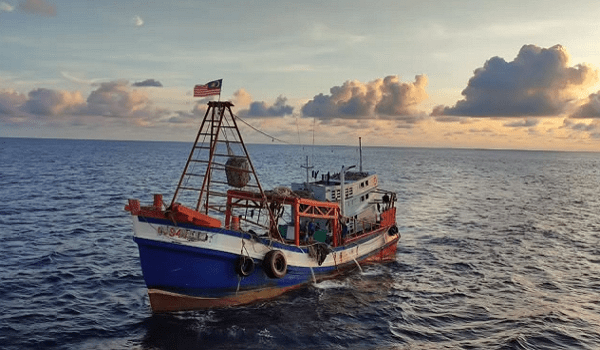Agriculture and Food Industries Minister Datuk Seri Ronald Kiandee said that Malaysia’s per capita consumption of fish and seafood in Malaysia has been 46.9 kg annually and ranks second in Southeast Asia behind Cambodia’s 63.2 kg annual consumption.
However, it’s reported a few months ago that the sighting of fish in Malaysia had decreased, especially in the north of the peninsula, by up to 70%, as highlighted by the Chairman of National Fishermen’s Association (Nekmat) Abdul Hamid Bahari. According to an unnamed source from the Fisheries Department, the issue of the decrease in fish sightings started in 2015 due to the enormous number of catches every year, with illegal fishing as one of the primary causes.
It’s part of the broader global trend as noted by the Food and Agriculture Organization of the United Nations (FAO) which reported in 2018 that almost 90% of the world’s fish stocks are fully exploited, overexploited, or depleted (see “90% of fish stocks are used up – fisheries subsidies must stop”, United Nations Conference on Trade and Development/Unctad, July 13, 2018).
It’s no surprise then that the South China Sea, home to “half” of Southeast Asia’s main fishing hotspot is also facing the same predicament. This is because, in this region, overfishing occurs due to illegal, unreported, and unregulated fishing (IIU).
For example, the total catch per unit effort in the Gulf of Thailand – which is adjacent to the South China Sea – has decreased by 86% since 1966 (see “The threat of overfishing”, The Asean Post, September 17, 2018).
In Malaysia, we lost RM6 billion to IUU fishing in 2016, and even though enforcement and monitoring were tightened, we still lost RM4.2 billion in 2019. Again, overfishing and poaching – which includes harmful fishing techniques such as fish bombing or blast fishing, the use of dragon traps and push nets, bottom trawling, etc. as well as encroachments by foreign fishermen – have all contributed to the decrease in our fish stocks.
The World Wildlife Fund of Malaysia reports that bottom trawling which sweeps up everything on the ocean floor is one of the most destructive fishing methods and is responsible for the destruction of thriving marine ecosystems, including coral reefs. Some of the fish species that fishermen used to capture 30 to 40 years ago are no longer being seen in the oceans.
Last year, the investigative journalism team reported that the decline in fish stocks under our Economic Exclusive Zone (EEZ) facing the South China Sea has been noticeable since the influx of foreign fishermen, especially Vietnamese trawlers.
Since fisheries is a regional issue, there’s a need for stronger and more concerted regional cooperation among ASEAN member states (AMS).
At the bilateral level, Malaysia and Indonesia this year have agreed to host joint patrols along the Straits of Malacca and North Natuna Sea which connect both countries with the aim of reinforcing maritime security against illegal fishing. The Indonesian Marine Affairs and Fisheries Minister Sakti Wahyu Trenggono said that illegal vessels are usually the ones that harm the sustainability of fish stocks due to their overfishing and destructive fishing practices (see “Indonesia, Malaysia to hold joint patrols against illegal fishing”, Mongabay, February 1, 2022).
The joint patrol should also be done together with other AMS to combat IUU in the South China Sea – which can build on the policy contents under the Development of an ASEAN General Fisheries Policy (AGFP) Feasibility Study Report (2020).
- As of February 2022, Thailand has imposed a temporary moratorium (ban) on commercial fishing in the Gulf of Thailand until mid-June this year to rebuild marine resources in the meantime.
The prohibition is being implemented in two stages. The first covers 27,000 square kilometres and the second covers 5,300 square kilometres.
This policy measure should also be considered as part of an ASEAN action plan to promote the recovery of fish stocks in the South China Sea and Straits of Malacca, etc.
Currently, Asean only has a Strategic Plan of Action on ASEAN Cooperation on Fisheries 2021-2025 which has six strategic thrusts.
- Notwithstanding, we should still strive for a Common Fisheries Policy (CFP) – similar to the EU (European Union) where we can set quotas on the total allowable catches (TAC) and the concomitant of landing obligations (i.e., the number or amount of fish netted or deducted against the TAC quotas), enforce the ban on destructive fishing practices more effectively and on a sustainable basis, enable and empower systematic joint-action on a regional basis, etc. with the exception of freedom of movement, i.e., of fishermen and fishing vessels.
After all, Asean has already sought the technical assistance of the EU for its fisheries policy framework under the Enhanced Regional EU-ASEAN Dialogue Instrument (E-READI).
Instead, as proposed we also suggested that Asean’s version of a CFP be used to support massive aquafarming projects in border regions that “capture” and re-designate the smooth cross-border movement of fishes within the zonal limits for the purpose of commercial breeding.
This not only promotes joint/cross-border investment from the private sector but also a more viable alternative to deep-sea fishing which can often result in an unfair playing field, among others.
Jason Loh and Anis Salwana Abdul Malik are part of the research team of EMIR Research, an independent think tank focused on strategic policy recommendations based on rigorous research.









